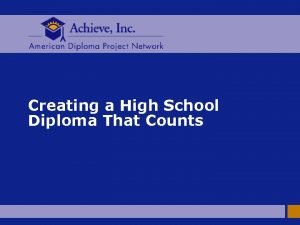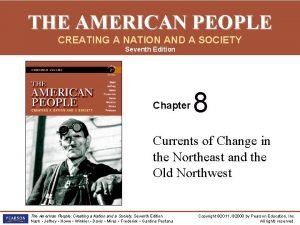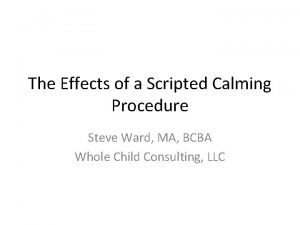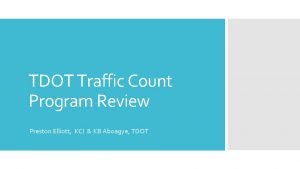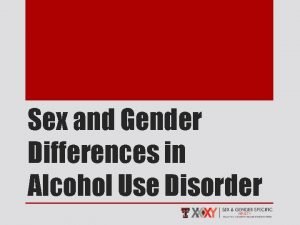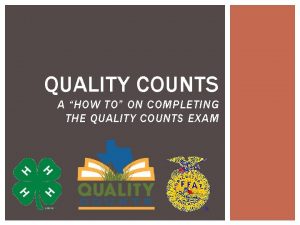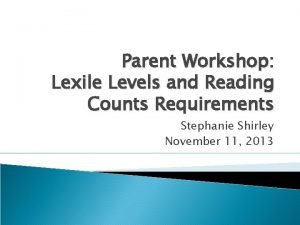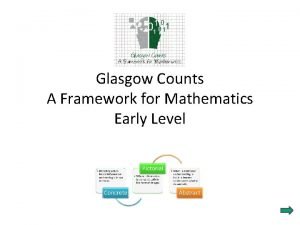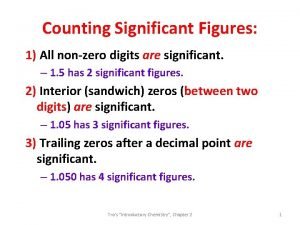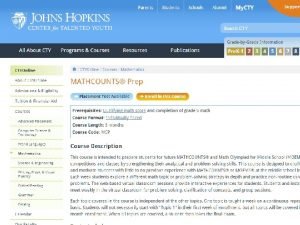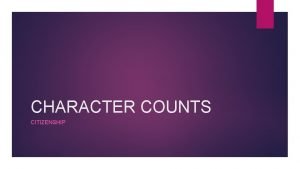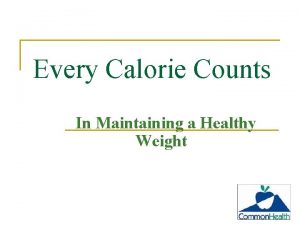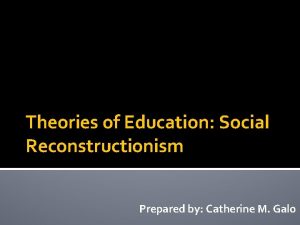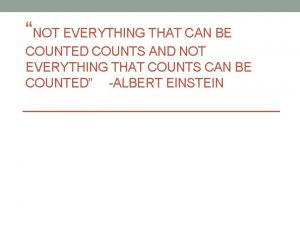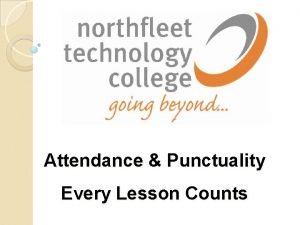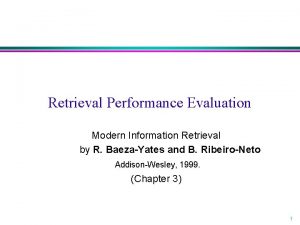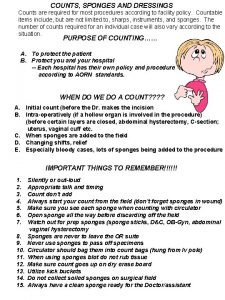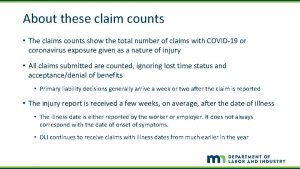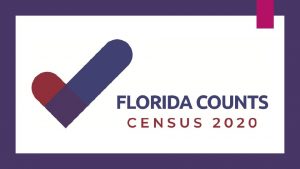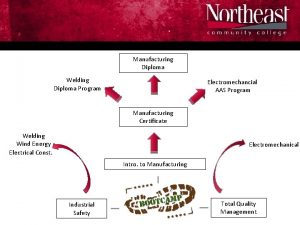Creating a High School Diploma That Counts American























































- Slides: 55

Creating a High School Diploma That Counts

American Diploma Project n n How well prepared are our students for the world after high school? What does it mean to be prepared for college and work? Do we expect all of our students to be prepared? Closing the expectations gap — what will it take? AMERICAN DIPLOMA PROJECT NETWORK 2

American Diploma Project How well prepared are our students? AMERICAN DIPLOMA PROJECT NETWORK 3

A high school diploma is not the last educational stop required Share of new jobs, 2000– 10 n Jobs that require at least some postsecondary education will make up more than two-thirds of new jobs. Source: Carnevale, Anthony P. and Donna M. Desrochers, Standards for What? The Economic Roots of K – 16 Reform, Educational Testing Service, 2003. AMERICAN DIPLOMA PROJECT NETWORK 4

Too many U. S. students drop out of the education pipeline Source: National Center for Public Policy & Higher Education, Policy Alert, April 2004. Data are estimates of pipeline progress rather than actual cohort. AMERICAN DIPLOMA PROJECT NETWORK 5

Only about half of African American and Latino students graduate from high school in four years On-time high school graduation, 2002 Source: Manhattan Institute, Public High School Graduation and College-Readiness Rates: 1991– 2002, February 2005, http: //www. manhattan-institute. org/html/ewp_08. htm. AMERICAN DIPLOMA PROJECT NETWORK 6

U. S. high school graduation rates have dropped over past 20 years Public high school graduation rates, 1981– 2000 Source: Mortenson, T. , “Chance for College by Age 19 by State in 2000, ” Postsecondary Education Opportunity: The Environmental Scanning Research Letter of Opportunity for Postsecondary Education, No. 123, The Mortenson Research Center on Public Policy, September 2002. AMERICAN DIPLOMA PROJECT NETWORK 7

High school graduation rate: United States trails most countries Source: Organisation for Economic Co-operation and Development, Education at a Glance 2004, 2004. AMERICAN DIPLOMA PROJECT NETWORK 8

Very few high school graduates are “college ready” Source: Manhattan Institute, Public High School Graduation and College-Readiness Rates: 1991– 2002, February 2005, http: //www. manhattan-institute. org/html/ewp_08. htm. AMERICAN DIPLOMA PROJECT NETWORK 9

Too few minority students in U. S. graduate from high school “college ready” Source: Manhattan Institute, Public High School Graduation and College-Readiness Rates: 1991– 2002, February 2005, http: //www. manhattan-institute. org/html/ewp_08. htm. AMERICAN DIPLOMA PROJECT NETWORK 10

College bound does not necessarily mean college ready Percentage of U. S. first-year students in two-year and four-year institutions requiring remediation n Nearly three in 10 first-year students are placed immediately into a remedial college course. Source: National Center for Education Statistics, Remedial Education at Degree-Granting Postsecondary Institutions in Fall 2000, 2003. AMERICAN DIPLOMA PROJECT NETWORK 11

Most U. S. college students who take remedial courses fail to earn degrees Percentage not earning degree by type of remedial coursework n Many college students who need remediation, especially in reading and math, do not earn either an associate’s or a bachelor’s degree. Source: National Center for Education Statistics, The Condition of Education, 2004. AMERICAN DIPLOMA PROJECT NETWORK 12

Many high school graduates cite gaps in preparation How well did your high school education prepare you for college or the work/jobs you hope to get in the future? n Very well: generally able to do what’s expected n Extremely well: prepared for everything n Somewhat well: some gaps n Not well: large gaps/struggling 61% 53% 46% 39% High school graduates who went to college High school graduates who did not go to college Source: Peter D. Hart Research Associates/Public Opinion Strategies, Rising to the Challenge: Are High School Graduates Prepared for College and Work? prepared for Achieve, Inc. , 2005. AMERICAN DIPLOMA PROJECT NETWORK 13

College instructors/employers confirm high school graduates’ lack of preparation Average estimated proportions of recent high school graduates who are not prepared 42% High school graduates not prepared for college-level classes 45% High school graduates not prepared to advance beyond entry-level jobs Source: Peter D. Hart Research Associates/Public Opinion Strategies, Rising to the Challenge: Are High School Graduates Prepared for College and Work? prepared for Achieve, Inc. , 2005. AMERICAN DIPLOMA PROJECT NETWORK 14

American Diploma Project What does it take to be prepared for postsecondary education and work? AMERICAN DIPLOMA PROJECT NETWORK 15

American Diploma Project n n n Partnership of Achieve, Inc. ; The Education Trust; and the Thomas B. Fordham Foundation. Partnered with Indiana, Kentucky, Massachusetts, Nevada and Texas. Involved wide variety of K– 12, higher education and business representatives. Created end-of-high-school benchmarks to convey the knowledge and skills graduates will need to be successful in college and the workplace. Key finding: Unprecedented convergence of skills required for success in college and work. AMERICAN DIPLOMA PROJECT NETWORK 16

Today’s graduates need more knowledge and skills n Highly Paid Professional Jobs Earnings: $40, 000+ Projected Job Growth Rate: 20% n Well-Paid, Skilled Jobs Earnings: $25, 000–$40, 000 Projected Job Growth Rate: 12% n Low-Paid or Low-Skilled Jobs Earnings: Less than $25, 000 Projected Job Growth Rate: 15% 25% 37% 38% Share of Jobs Source: American Diploma Project, 2002. AMERICAN DIPLOMA PROJECT NETWORK 17

What does it take to succeed in “good” jobs? ADP research found that: n 84 percent of highly paid professionals (top tier of pyramid) took Algebra II or higher in high school. n Employees in vast majority of good jobs took four years of grade-level English. n Employers emphasize importance of workers being able to think creatively and logically and to identify and solve problems. n Fastest growing occupations require some education beyond high school (e. g. , certificate, bachelor’s degree, associate degree, on-the-job training). AMERICAN DIPLOMA PROJECT NETWORK 18

Even blue-collar jobs require high -level skills n Requirements for tool and die makers l l n Four or five years of apprenticeship and/or postsecondary training Algebra, geometry, trigonometry and statistics Requirements for sheet metal workers l l Four or five years of apprenticeship Algebra, geometry, trigonometry and technical reading Source: American Diploma Project, 2002. AMERICAN DIPLOMA PROJECT NETWORK 19

ADP expectations ensure high school graduates are prepared to succeed n In English, the benchmarks cover: l l l l n Language Communication Writing Research Logic Informational text Media Literature AMERICAN DIPLOMA PROJECT NETWORK In math, the benchmarks cover: l l l Number sense and numerical operations Algebra Geometry Data interpretations, statistics and probability Math reasoning skills 20

Whether graduates are going to college or work, they need the same skills Machine Operator Eastman Chemical Company College Algebra Required Skills: l Add, subtract, multiply, divide and simplify rational expressions l Calculate and apply ratios, proportions and percentages to solve problems l Recognize and solve problems using a linear equation and one variable l Apply units correctly in expressions involving measurements l Determine the perimeter and the circumference of geometric shapes Required Skills: l Add, subtract, multiply, divide and simplify rational expressions l Understand functional notation l Solve systems of two linear equations in two variables l Solve quadratic equations in one variable l Graph a linear equation and quadratic function l Determine the perimeter and the circumference of geometric shapes l Represent geometric objects and figures algebraically AMERICAN DIPLOMA PROJECT NETWORK 21

To be college and work ready, students need to complete a rigorous sequence of courses To cover the content in the ADP benchmarks, high school graduates need: n In math: n In English: l l Four courses Content equivalent to Algebra I and II, Geometry, and a fourth course such as Statistics or Precalculus AMERICAN DIPLOMA PROJECT NETWORK l l Four courses Content equivalent to four years of grade-level English or higher (i. e. , honors or AP English) 22

American Diploma Project What do we expect of our high school graduates? n Standards n Course-taking requirements n Assessments AMERICAN DIPLOMA PROJECT NETWORK 23

State high school standards not always anchored in real-world expectations n n In most states, standards reflect a consensus among discipline-based experts about what would be important for young people to learn – not a reflection of what would be essential to know to succeed at the next level. Few states’ postsecondary faculty and employers have verified that state high school standards reflect their expectations. AMERICAN DIPLOMA PROJECT NETWORK 24

Do state graduation requirements reflect “college- and work-ready” content? To answer this question, Achieve: n Reviewed minimum high school course requirements in all 50 states. n Compared each state’s requirements to what students need to be successful in college and the workplace. AMERICAN DIPLOMA PROJECT NETWORK 25

42 states require students to take certain courses to graduate from high school Source: Achieve, Inc. , The Expectations Gap: A 50 -State Review of High School Graduation Requirements, 2004. AMERICAN DIPLOMA PROJECT NETWORK 26

20 states require Algebra I Source: Achieve, Inc. , The Expectations Gap: A 50 -State Review of High School Graduation Requirements, 2004. AMERICAN DIPLOMA PROJECT NETWORK 27

13 states require Geometry Source: Achieve, Inc. , The Expectations Gap: A 50 -State Review of High School Graduation Requirements, 2004. AMERICAN DIPLOMA PROJECT NETWORK 28

Only 3 states require Algebra II Source: Achieve, Inc. , The Expectations Gap: A 50 -State Review of High School Graduation Requirements, 2004. AMERICAN DIPLOMA PROJECT NETWORK 29

A strong high school curriculum* improves college completion and narrows gaps 13% 30% *Completing at least Algebra II plus other courses. Source: Adapted from Adelman, Clifford, U. S. Department of Education, Answers in the Toolbox, 1999. AMERICAN DIPLOMA PROJECT NETWORK 30

Only four in 10 high school students complete a college- and work-ready math curriculum Taking a math course beyond Algebra II* by graduation (2002) *Trigonometry or Precalculus. Source: Council of Chief State School Officers, State Indicators of Science and Mathematics Education 2002, 2003, p. 27. AMERICAN DIPLOMA PROJECT NETWORK 31

Do assessments measure “college -ready” skills? n Half the states require students to pass one or more exams to earn a high school diploma. What does it take to pass these tests? AMERICAN DIPLOMA PROJECT NETWORK 32

The tests Achieve analyzed Source: Achieve, Inc. , Do Graduation Tests Measure Up? A Closer Look at State High School Exit Exams, 2004. AMERICAN DIPLOMA PROJECT NETWORK 33

Good news: States are measuring algebra and geometry Source: Achieve, Inc. , Do Graduation Tests Measure Up? A Closer Look at State High School Exit Exams, 2004. AMERICAN DIPLOMA PROJECT NETWORK 34

Bad news: States tend to measure lower-level content Source: Achieve, Inc. , Do Graduation Tests Measure Up? A Closer Look at State High School Exit Exams, 2004. AMERICAN DIPLOMA PROJECT NETWORK 35

Students can pass state math tests knowing content typically taught in 7 th and 8 th grade internationally Grade when most international students cover content required to pass state math tests FL MD MA NJ OH TX Source: Achieve, Inc. , Do Graduation Tests Measure Up? A Closer Look at State High School Exit Exams, 2004. AMERICAN DIPLOMA PROJECT NETWORK 36

Reading tests downplay higher-level skills Source: Achieve, Inc. , Do Graduation Tests Measure Up? A Closer Look at State High School Exit Exams, 2004. AMERICAN DIPLOMA PROJECT NETWORK 37

Students can pass state English tests with skills ACT expects of 8 th and 9 th graders ACT EXPLORE (8 th/9 th) ACT PLAN (10 th) ACT (11 th/12 th) FL MD MA NJ OH TX Source: Achieve, Inc. , Do Graduation Tests Measure Up? A Closer Look at State High School Exit Exams, 2004. AMERICAN DIPLOMA PROJECT NETWORK 38

American Diploma Project What do recent high school graduates tell us about the expectations they faced? AMERICAN DIPLOMA PROJECT NETWORK 39

Most high school graduates were moderately challenged All high school graduates College students Students who did not go to college Source: Peter D. Hart Research Associates/Public Opinion Strategies, Rising to the Challenge: Are High School Graduates Prepared for College and Work? prepared for Achieve, Inc. , 2005. AMERICAN DIPLOMA PROJECT NETWORK 40

Graduates who faced high expectations in high school twice as likely to feel prepared for future Percentage saying they were extremely/very well prepared Source: Peter D. Hart Research Associates/Public Opinion Strategies, Rising to the Challenge: Are High School Graduates Prepared for College and Work? prepared for Achieve, Inc. , 2005. AMERICAN DIPLOMA PROJECT NETWORK 41

Algebra II critical for college and work High school graduates extremely or very well prepared for expectations of college/work Source: Peter D. Hart Research Associates/Public Opinion Strategies, Rising to the Challenge: Are High School Graduates Prepared for College and Work? prepared for Achieve, Inc. , 2005. AMERICAN DIPLOMA PROJECT NETWORK 42

Writing critical for college and work High school graduates extremely or very well prepared for expectations of college/work Source: Peter D. Hart Research Associates/Public Opinion Strategies, Rising to the Challenge: Are High School Graduates Prepared for College and Work? prepared for Achieve, Inc. , 2005. AMERICAN DIPLOMA PROJECT NETWORK 43

Knowing what they know today, high school graduates would have worked harder Source: Peter D. Hart Research Associates/Public Opinion Strategies, Rising to the Challenge: Are High School Graduates Prepared for College and Work? prepared for Achieve, Inc. , 2005. AMERICAN DIPLOMA PROJECT NETWORK 44

If high school had demanded more, graduates would have worked harder n Would have worked harder n Strongly feel I would have worked harder 82% High school graduates who went to college n Wouldn’t have worked harder 80% High school graduates who did not go to college Source: Peter D. Hart Research Associates/Public Opinion Strategies, Rising to the Challenge: Are High School Graduates Prepared for College and Work? prepared for Achieve, Inc. , 2005. AMERICAN DIPLOMA PROJECT NETWORK 45

Majority of graduates would have taken harder courses Knowing what you know today about the expectations of college/work … Would have taken more challenging courses in at least one area Would have taken more challenging courses in: Math Science English AMERICAN DIPLOMA PROJECT NETWORK Source: Peter D. Hart Research Associates/Public Opinion Strategies, Rising to the Challenge: Are High School Graduates Prepared for College and Work? prepared for Achieve, Inc. , 2005. 46

American Diploma Project What will it take to close the expectations gap? AMERICAN DIPLOMA PROJECT NETWORK 47

Closing the expectations gap requires states to take action n Align high school standards and assessments with the knowledge and skills required for success in postsecondary education and work. n Administer a college- and work-ready assessment, aligned to state standards, to high school students so they get clear and timely information and are able to address critical skill deficiencies while still in high school. n Require all students to take a college- and work-ready curriculum to earn a high school diploma. n Hold high schools accountable for graduating students who are college ready, and hold postsecondary institutions accountable for their success once enrolled. AMERICAN DIPLOMA PROJECT NETWORK 48

Postsecondary must be involved What does it take to align high school standards with “college-ready” standards? n A clear, consistent definition of “college ready” from state postsecondary institutions. AMERICAN DIPLOMA PROJECT NETWORK 49

Some states are using high school assessments for postsecondary purposes n n California State University system augmented the state’s high school test and now uses it for placement purposes. City University of New York uses scores on the state’s Regents exam for admissions and placement purposes. Texas students who earn a certain score on the state TAKS exam can be placed in college-level courses. Some states are considering incorporating the SAT or ACT into their high school assessment systems. AMERICAN DIPLOMA PROJECT NETWORK 50

High schools must be held accountable for student preparation To ensure high schools are graduating students who are “college and work ready, ” states need: n n A data system based on individual student unit records that permits an honest count of graduation and dropout rates Measures of college and work readiness aligned to state standards AMERICAN DIPLOMA PROJECT NETWORK 51

Postsecondary institutions must be held accountable for student success Holding postsecondary institutions accountable for the success of the students they admit requires: n n n Focused goals for each institution, including persistence and graduation rates Data systems linked to K– 12 Appropriate incentives AMERICAN DIPLOMA PROJECT NETWORK 52

ADP Network: 18 states committed to improving student achievement AMERICAN DIPLOMA PROJECT NETWORK 53

Creating a High School Diploma That Counts

For more information, please visit Achieve, Inc. , on the Web at http: //www. achieve. org AMERICAN DIPLOMA PROJECT NETWORK 55
 Nostrification of high school diploma
Nostrification of high school diploma Phân độ lown ngoại tâm thu
Phân độ lown ngoại tâm thu Block av độ 1
Block av độ 1 Thơ thất ngôn tứ tuyệt đường luật
Thơ thất ngôn tứ tuyệt đường luật Thơ thất ngôn tứ tuyệt đường luật
Thơ thất ngôn tứ tuyệt đường luật Chiến lược kinh doanh quốc tế của walmart
Chiến lược kinh doanh quốc tế của walmart Tìm vết của mặt phẳng
Tìm vết của mặt phẳng Con hãy đưa tay khi thấy người vấp ngã
Con hãy đưa tay khi thấy người vấp ngã Tôn thất thuyết là ai
Tôn thất thuyết là ai Gây tê cơ vuông thắt lưng
Gây tê cơ vuông thắt lưng Sau thất bại ở hồ điển triệt
Sau thất bại ở hồ điển triệt American diploma project
American diploma project The american people creating a nation and a society
The american people creating a nation and a society American high school
American high school American high school
American high school Crescenta valley high school summer school
Crescenta valley high school summer school Haltom high school summer school
Haltom high school summer school Steve ward calm counts
Steve ward calm counts Tdot traffic counts
Tdot traffic counts Cage questionaire
Cage questionaire It consists of numbers representing counts or measurements
It consists of numbers representing counts or measurements How many lessons are in quality counts
How many lessons are in quality counts Will counts
Will counts Sri reading counts
Sri reading counts Bias by photos captions and camera angles examples
Bias by photos captions and camera angles examples Every opportunity counts
Every opportunity counts Make every opportunity count
Make every opportunity count Bias through source control
Bias through source control Glasgow counts framework
Glasgow counts framework What are significant figures in chemistry
What are significant figures in chemistry Mathcounts prep
Mathcounts prep Semcog traffic counts
Semcog traffic counts Everyday calendar math
Everyday calendar math Character counts citizenship
Character counts citizenship Louise skip counts by 4 on a number line
Louise skip counts by 4 on a number line Bias through statistics and crowd counts examples
Bias through statistics and crowd counts examples Trrfcc character counts
Trrfcc character counts P e d e s t r i a n t r a f f i c d a t a
P e d e s t r i a n t r a f f i c d a t a Reading counts pdsd
Reading counts pdsd It is not the critic who counts
It is not the critic who counts Every calorie counts
Every calorie counts Summer counts
Summer counts Nationwide data collection
Nationwide data collection What counts as commercial photography
What counts as commercial photography George counts reconstructionism
George counts reconstructionism Not everything that counts can be counted meaning
Not everything that counts can be counted meaning Ibm cloud orchestration
Ibm cloud orchestration Robin counts
Robin counts Every lesson counts
Every lesson counts High precision vs high recall
High precision vs high recall High precision vs high recall
High precision vs high recall Directive behavior and supportive behavior
Directive behavior and supportive behavior High expectations high support
High expectations high support Significant figures
Significant figures High directive and low supportive behavior
High directive and low supportive behavior High risk high return artinya
High risk high return artinya











